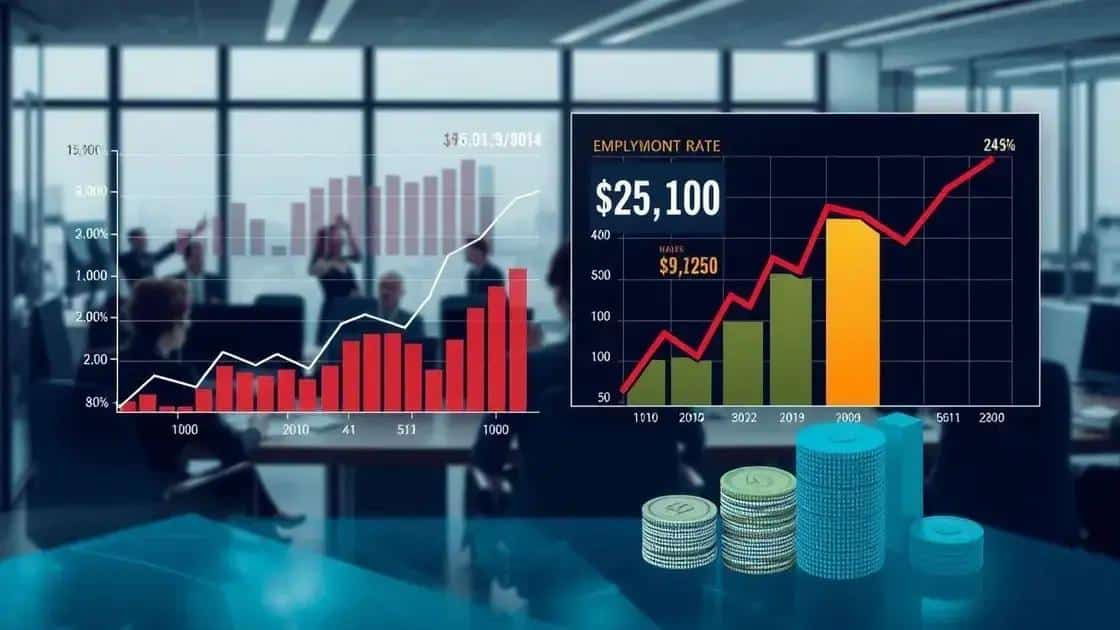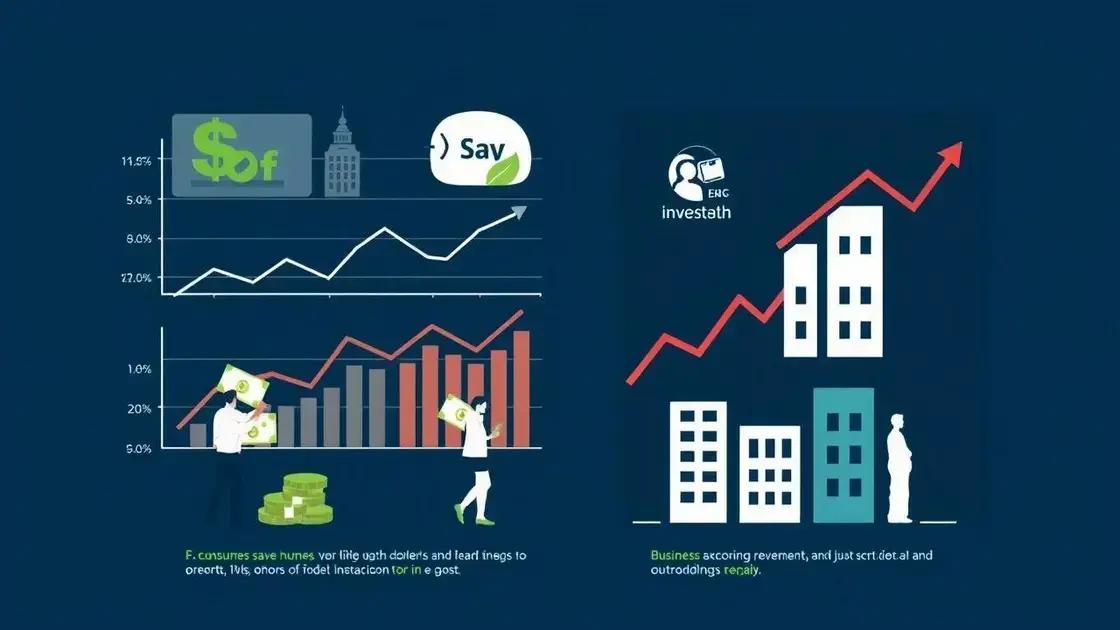Federal Reserve maintains restrictive monetary policy to control inflation

A restrictive monetary policy aims to control inflation by raising interest rates, impacting consumer borrowing and spending, which can slow economic growth and lead to market fluctuations.
Federal Reserve maintains restrictive monetary policy as a crucial strategy to combat inflation and stabilize the economy. But have you considered how these choices affect your daily life? Let’s dive into the details.
Understanding the Federal Reserve’s role in monetary policy
The Federal Reserve plays a crucial role in shaping the monetary policy of the United States. It helps guide the economy towards stability and growth. By adjusting interest rates, the Fed can influence spending and investment.
What Does the Federal Reserve Do?
Understanding its functions is essential. The Fed manages the money supply, regulates banks, and provides financial services. It sets interest rates, ensuring that credit is available when needed.
Influence of Interest Rates
When the Fed lowers interest rates, loans become cheaper. This encourages spending and investment. Conversely, higher rates can slow down inflation by making borrowing more expensive.
- Cheap loans stimulate economic growth.
- Higher rates combat inflation risks.
- The Fed’s adjustments affect everyday consumers.
Additionally, the Fed monitors inflation closely. By balancing growth with price stability, it aims to keep the economy healthy. This ongoing adjustment is vital in responding to economic changes.
Every decision made by the Federal Reserve impacts all of us. As it implements its policies, communities feel the ripple effects. By understanding the Fed’s role, we become more informed citizens about our economy.
Impacts of restrictive monetary policies on the economy

Restrictive monetary policies can significantly affect the overall economy, impacting everything from inflation rates to employment levels. By tightening the money supply, the Federal Reserve influences how much money circulates in the economy.
Effects on Inflation
One major impact is on inflation. When the Fed raises interest rates, it becomes more expensive to borrow money. This can slow down spending by consumers and businesses, leading to reduced demand for goods and services. Over time, this can help stabilize prices.
Employment Consequences
Conversely, higher interest rates can lead to slower economic growth. This may result in businesses hiring less or even laying off employees. As borrowing costs rise, companies may hold back on investments that lead to job creation.
- Reduced consumer spending can lead to slower economic growth.
- Businesses may stagnate due to increased borrowing costs.
- Job creation can slow down or decline.
The tightening of monetary policy also affects the stock market. Investors may react to rising rates by pulling funds out of stocks, causing market fluctuations. The sentiment around risk changes, as potential returns on investments can diminish during these periods.
Moreover, international markets feel the effects too. A strong dollar can emerge due to higher interest rates, affecting exports negatively. Products made in the U.S. become more expensive for foreign buyers, reducing demand abroad.
What a restrictive monetary policy means for consumers
A restrictive monetary policy has various implications for consumers, primarily affecting their financial choices and purchasing power. As the Federal Reserve raises interest rates, borrowing becomes more expensive. This increase impacts loans, credit cards, and mortgages.
Higher Interest Rates and Its Effects
When interest rates go up, consumers often see higher rates on loans. For example, mortgage rates can rise, making home buying less affordable. This situation leads many people to reconsider major purchases, affecting economic growth.
Changes in Spending Habits
With higher borrowing costs, consumers tend to reduce their spending. They may choose to save more money instead of spending on non-essential items. This cautious approach impacts businesses, as lower consumer spending can lead to reduced sales.
- Home buying becomes more expensive due to higher rates.
- Consumers may prioritize saving over spending.
- Businesses face challenges with declining sales.
Furthermore, inflation can remain a concern during restrictive periods. As costs for everyday goods rise, consumers feel the pinch in their wallets. They may notice that their purchasing power decreases if wages do not keep up with inflation, leading to further financial strain.
The overall effects of a restrictive monetary policy create a cautious environment for consumers. Understanding these dynamics helps people navigate their finances better and plan for their future. Overall, the goal of these policies is to stabilize the economy and control inflation, but the impacts on consumers can be significant.
Future implications of maintaining a restrictive stance

Maintaining a restrictive monetary stance can have significant long-term implications for the economy. As the Federal Reserve continues to manage interest rates, their decisions ripple through various sectors, influencing growth and stability.
Long-Term Economic Growth
One major concern is the impact on economic growth. When rates are kept high for too long, businesses may hesitate to invest in expansion. This can lead to slower growth as new projects and job opportunities are put on hold.
Consumer Investment and Savings
Consumers also feel the effects of a restrictive policy. Higher interest rates can lead to increased savings as individuals seek to take advantage of better returns on savings accounts. However, this also means they might spend less, affecting businesses that rely on consumer spending.
- Slower investment in businesses can hinder innovation.
- Consumers may save more but spend less, impacting sales.
- A prolonged restrictive stance could slow job creation.
Furthermore, while controlling inflation is essential, a prolonged restrictive policy can lead to challenges. If the economy starts to contract due to reduced spending, the Fed might eventually need to pivot to a more accommodative approach. This shift can create uncertainty in the markets.
As interest rates fluctuate, international markets will also respond. A strong U.S. dollar may impact imports and exports, presenting challenges for American manufacturers. Understanding these dynamics helps businesses and consumers prepare for potential changes in the economic landscape.
FAQ – Understanding the Impacts of Restrictive Monetary Policy
What is restrictive monetary policy?
Restrictive monetary policy is when the Federal Reserve raises interest rates to reduce the money supply and control inflation.
How does restrictive monetary policy affect consumers?
It leads to higher borrowing costs, which can make loans, mortgages, and credit cards more expensive, causing consumers to spend less.
What are the implications for businesses under restrictive monetary policy?
Businesses may delay investments and expansion due to higher costs of borrowing, which can slow down economic growth.
What happens to the economy if restrictive policies are maintained for too long?
If maintained for too long, it can lead to slower economic growth, reduced consumer spending, and potential market volatility.






